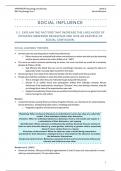Summary
Summary Psychology and Society Social Influence Notes
- Course
- Institution
- Book
Complete revision and summary notes for Social Influence for BSc Psychology: Psychology and Society Module. Written by a straight A* King's College London student set for a 1st. Well organised and in order. Includes diagrams and full reference section and collated information from class, textb...
[Show more]




